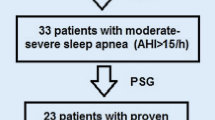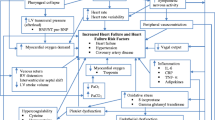Abstract
Background
Cardiac troponins (cTn) are to date the most sensitive and specific biochemical markers of myocardial injury. Abnormal breathing patterns in patients with obstructive sleep apnea (OSA) may cause myocardial cell stress detectable by novel cTn assays. The objectives of this study were to investigate whether a new single-molecule cTnI (S-cTnI) assay and a commercially available high-sensitivity cTnT (hs-cTnT) assay would detect myocyte injury in individuals evaluated for possible OSA, and to explore their relation to variables of disordered breathing during sleep.
Methods
Consecutive individuals referred to Lovisenberg Diakonale Hospital’s sleep laboratory between 1 October 2009 and 1 March 2010 were included. We measured cTn in specimens collected the morning after sleep and studied these in relation to variables recorded during polygraphy or polysomnography.
Results
All 222 (100 %) individuals had measurable cTn levels using either assay. Stratified into categories according to the apnea–hypopnea index (AHI), patients with OSA (AHI ≥5) had a different distribution of S-cTnI (P = 0.036) and hs-cTnT (P = 0.002) compared to those without (AHI <5). The median (quartiles 1–3) were 3.0 (1.9–6.0) versus 2.3 (1.6–3.8) ng/l for S-cTnI, and 7.0 (5.5–8.7) versus 6.2 (4.9–7.2) ng/l for hs-cTnT. However, in multiple median regression analyses adjusted for conventional predictors, neither S-cTnI (P = 0.57) nor hs-cTnT (P = 0.80) were significantly associated with AHI.
Conclusions
This study reveals no association independent of conventional predictors between OSA and myocardial cell injury measured by S-cTnI and hs-cTnT assays. Our findings support a search for novel biomarkers for prognostication of OSA.

Similar content being viewed by others
Abbreviations
- AHI:
-
Apnea–hypopnea index
- cTn:
-
Cardiac troponin
- CVD:
-
Cardiovascular disease
- EMG:
-
Electromyogram
- hs-cTnT:
-
High-sensitivity cardiac troponin T
- LoB:
-
Limit of blank
- LoD:
-
Limit of detection
- LoQ:
-
Limit of quantification
- OSA:
-
Obstructive sleep apnea
- PG:
-
Polygraphy
- PSG:
-
Polysomnography
- S-cTnI:
-
Single-molecule cardiac troponin I
References
Hrubos-Strom H, Randby A, Namtvedt SK, Kristiansen HA, Einvik G, Benth J, Somers VK, Nordhus IH, Russell MB, Dammen T, Omland T, Kvaerner KJ (2011) A Norwegian population-based study on the risk and prevalence of obstructive sleep apnea. The Akershus Sleep Apnea Project (ASAP). J Sleep Res 20:162–170
Young T, Shahar E, Nieto FJ, Redline S, Newman AB, Gottlieb DJ, Walsleben JA, Finn L, Enright P, Samet JM (2002) Predictors of sleep-disordered breathing in community-dwelling adults: the Sleep Heart Health Study. Arch Intern Med 162:893–900
Gottlieb DJ, Yenokyan G, Newman AB, O’Connor GT, Punjabi NM, Quan SF, Redline S, Resnick HE, Tong EK, Diener-West M, Shahar E (2010) Prospective study of obstructive sleep apnea and incident coronary heart disease and heart failure: the sleep heart health study. Circulation 122:352–360
Marshall NS, Wong KK, Liu PY, Cullen SR, Knuiman MW, Grunstein RR (2008) Sleep apnea as an independent risk factor for all-cause mortality: the Busselton Health Study. Sleep 31:1079–1085
Shah NA, Yaggi HK, Concato J, Mohsenin V (2010) Obstructive sleep apnea as a risk factor for coronary events or cardiovascular death. Sleep Breath 14:131–136
Agewall S, Giannitsis E, Jernberg T, Katus H (2011) Troponin elevation in coronary vs. non-coronary disease. Eur Heart J 32:404–411
Thygesen K, Alpert JS, Jaffe AS, Simoons ML, Chaitman BR, White HD (2012) Third universal definition of myocardial infarction. Eur Heart J 33:2551–2567
de Lemos JA, Drazner MH, Omland T, Ayers CR, Khera A, Rohatgi A, Hashim I, Berry JD, Das SR, Morrow DA, McGuire DK (2010) Association of troponin T detected with a highly sensitive assay and cardiac structure and mortality risk in the general population. JAMA 304:2503–2512
deFilippi CR, de Lemos JA, Christenson RH, Gottdiener JS, Kop WJ, Zhan M, Seliger SL (2010) Association of serial measures of cardiac troponin T using a sensitive assay with incident heart failure and cardiovascular mortality in older adults. JAMA 304:2494–2502
Omland T, de Lemos JA, Sabatine MS, Christophi CA, Rice MM, Jablonski KA, Tjora S, Domanski MJ, Gersh BJ, Rouleau JL, Pfeffer MA, Braunwald E (2009) A sensitive cardiac troponin T assay in stable coronary artery disease. N Engl J Med 361:2538–2547
Apple FS, Steffen LM, Pearce LA, Murakami MM, Luepker RV (2012) Increased cardiac troponin I as measured by a high-sensitivity assay is associated with high odds of cardiovascular death: the Minnesota Heart Survey. Clin Chem 58:930–935
Omland T, Pfeffer MA, Solomon SD, de Lemos JA, Rosjo H, Saltyte BJ, Maggioni A, Domanski MJ, Rouleau JL, Sabatine MS, Braunwald E (2013) Prognostic value of cardiac troponin I measured with a highly sensitive assay in patients with stable coronary artery disease. J Am Coll Cardiol 61:1240–1249
Todd J, Freese B, Lu A, Held D, Morey J, Livingston R, Goix P (2007) Ultrasensitive flow-based immunoassays using single-molecule counting. Clin Chem 53:1990–1995
Apple FS, Simpson PA, Murakami MM (2010) Defining the serum 99th percentile in a normal reference population measured by a high-sensitivity cardiac troponin I assay. Clin Biochem 43:1034–1036
Sabatine MS, Morrow DA, de Lemos JA, Jarolim P, Braunwald E (2009) Detection of acute changes in circulating troponin in the setting of transient stress test-induced myocardial ischaemia using an ultrasensitive assay: results from TIMI 35. Eur Heart J 30:162–169
Hanly P, Sasson Z, Zuberi N, Lunn K (1993) ST-segment depression during sleep in obstructive sleep apnea. Am J Cardiol 71:1341–1345
Schafer H, Koehler U, Ploch T, Peter JH (1997) Sleep-related myocardial ischemia and sleep structure in patients with obstructive sleep apnea and coronary heart disease. Chest 111:387–393
Kuniyoshi FH, Garcia-Touchard A, Gami AS, Romero-Corral A, van der Walt C, Pusalavidyasagar S, Kara T, Caples SM, Pressman GS, Vasquez EC, Lopez-Jimenez F, Somers VK (2008) Day–night variation of acute myocardial infarction in obstructive sleep apnea. J Am Coll Cardiol 52:343–346
Saenger AK, Beyrau R, Braun S, Cooray R, Dolci A, Freidank H, Giannitsis E, Gustafson S, Handy B, Katus H, Melanson SE, Panteghini M, Venge P, Zorn M, Jarolim P, Bruton D, Jarausch J, Jaffe AS (2011) Multicenter analytical evaluation of a high-sensitivity troponin T assay. Clin Chim Acta 412:748–754
Lydersen S, Fagerland MW, Laake P (2009) Recommended tests for association in 2 × 2 tables. Stat Med 28:1159–1175
Nieto FJ, Young TB, Lind BK, Shahar E, Samet JM, Redline S, D’Agostino RB, Newman AB, Lebowitz MD, Pickering TG (2000) Association of sleep-disordered breathing, sleep apnea, and hypertension in a large community-based study. Sleep Heart Health Study. JAMA 283:1829–1836
Seicean S, Kirchner HL, Gottlieb DJ, Punjabi NM, Resnick H, Sanders M, Budhiraja R, Singer M, Redline S (2008) Sleep-disordered breathing and impaired glucose metabolism in normal-weight and overweight/obese individuals: the Sleep Heart Health Study. Diabetes Care 31:1001–1006
Sorajja D, Gami AS, Somers VK, Behrenbeck TR, Garcia-Touchard A, Lopez-Jimenez F (2008) Independent association between obstructive sleep apnea and subclinical coronary artery disease. Chest 133:927–933
Namtvedt SK, Hisdal J, Randby A, Agewall S, Stranden E, Somers VK, Rosjo H, Omland T (2013) Impaired endothelial function in persons with obstructive sleep apnoea: impact of obesity. Heart 99:30–34
Kasai T, Floras JS, Bradley TD (2012) Sleep apnea and cardiovascular disease: a bidirectional relationship. Circulation 126:1495–1510
Narkiewicz K, van de Borne PJ, Cooley RL, Dyken ME, Somers VK (1998) Sympathetic activity in obese subjects with and without obstructive sleep apnea. Circulation 98:772–776
Gami AS, Svatikova A, Wolk R, Olson EJ, Duenwald CJ, Jaffe AS, Somers VK (2004) Cardiac troponin T in obstructive sleep apnea. Chest 125:2097–2100
Randby A, Namtvedt SK, Einvik G, Hrubos-Strom H, Hagve TA, Somers VK, Omland T (2012) Obstructive sleep apnea is associated with increased high-sensitivity cardiac troponin T levels. Chest 142:639–646
Shah N, Redline S, Yaggi HK, Wu R, Zhao CG, Ostfeld R, Menegus M, Tracy D, Brush E, Appel WD, Kaplan RC (2013) Obstructive sleep apnea and acute myocardial infarction severity: ischemic preconditioning? Sleep Breath 17:819–826
Zong P, Setty S, Sun W, Martinez R, Tune JD, Ehrenburg IV, Tkatchouk EN, Mallet RT, Downey HF (2004) Intermittent hypoxic training protects canine myocardium from infarction. Exp Biol Med (Maywood) 229:806–812
Lavie L, Lavie P (2010) Coronary collateral circulation in sleep apnea: a cardioprotective mechanism? Chest 137:511–512
Steiner S, Schueller PO, Schulze V, Strauer BE (2010) Occurrence of coronary collateral vessels in patients with sleep apnea and total coronary occlusion. Chest 137:516–520
Rosjo H, Kravdal G, Hoiseth AD, Jorgensen M, Badr P, Roysland R, Omland T (2012) Troponin I measured by a high-sensitivity assay in patients with suspected reversible myocardial ischemia: data from the Akershus Cardiac Examination (ACE) 1 study. Clin Chem 58:1565–1573
Tjora S, Gjestland H, Mordal S, Agewall S (2011) Troponin rise in healthy subjects during exercise test. Int J Cardiol 151:375–376
Kurz K, Giannitsis E, Zehelein J, Katus HA (2008) Highly sensitive cardiac troponin T values remain constant after brief exercise- or pharmacologic-induced reversible myocardial ischemia. Clin Chem 54:1234–1238
Ungerer JP, Marquart L, O’Rourke PK, Wilgen U, Pretorius CJ (2012) Concordance, variance, and outliers in 4 contemporary cardiac troponin assays: implications for harmonization. Clin Chem 58:274–283
Labugger R, Organ L, Collier C, Atar D, Van Eyk JE (2000) Extensive troponin I and T modification detected in serum from patients with acute myocardial infarction. Circulation 102:1221–1226
Apple FS, Collinson PO (2012) Analytical characteristics of high-sensitivity cardiac troponin assays. Clin Chem 58:54–61
Apple FS, Ler R, Murakami MM (2012) Determination of 19 cardiac troponin I and T assay 99th percentile values from a common presumably healthy population. Clin Chem 58:1574–1581
Collinson PO, Heung YM, Gaze D, Boa F, Senior R, Christenson R, Apple FS (2012) Influence of population selection on the 99th percentile reference value for cardiac troponin assays. Clin Chem 58:219–225
Acknowledgments
The authors want to acknowledge the Ear–Nose–Throat department at Lovisenberg Diakonale Hospital for their support and assistance throughout the study. We also acknowledge Michael J. Conrad (TIMI Clinical Trials Laboratory) and May Lill Madsen (Lovisenberg Diakonale Hospital) for their contribution on the biomarker analyses, and Christian Hall for valuable discussions and advice throughout the project. The study was supported by grants from Lovisenberg Diakonale Hospital’s research fund and the South-Eastern Norway Regional Health Authority. TSH also received a scholarship from AstraZeneca that funded some of the biomarker analyses. These institutions had no other involvement in the study.
Declaration of interest
PJ has consulted for T2 Biosystems and Quanterix and has received grant support from Abbott, AstraZeneca, Daiichi Sankyo, Merck, Roche Diagnostics and Waters Technologies. JH is an employee of Boehringer Ingelheim Norway, with the company not being involved in this study. SA has received speakers’ honoraria from AstraZeneca, Boehringer Ingelheim, Orion Pharma, Pfizer and Siemens. DA has received speakers’ honoraria from Siemens. The other authors have no disclosures.
Author information
Authors and Affiliations
Corresponding author
Rights and permissions
About this article
Cite this article
Hall, T.S., Herrscher, T., Jarolim, P. et al. Obstructive sleep apnea: no independent association to troponins. Sleep Breath 18, 351–358 (2014). https://doi.org/10.1007/s11325-013-0892-6
Received:
Revised:
Accepted:
Published:
Issue Date:
DOI: https://doi.org/10.1007/s11325-013-0892-6




